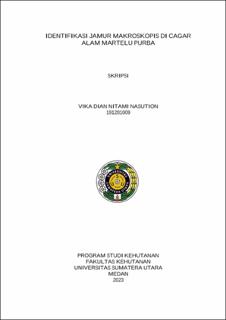Identifikasi Jamur Makroskopis di Cagar Alam Martelu Purba
Identification of Macroscopic Fungi in Martelu Purba Nature Reserve

Date
2023Author
Nasution, Vika Dian Nitami
Advisor(s)
Hartini, Kansih Sri
Rangkuti, Ahmad Baiquni
Metadata
Show full item recordAbstract
Fungi are organisms that enrich plant diversity. Fungi act as decomposers, along with bacteria and various types of protozoa, and are very useful in decomposing organic matter to accelerate the rotation of materials in the forest ecosystem. The purpose of this study was to obtain data on macroscopic fungal species and their benefits in the Martelu Purba Nature Reserve area. The research was conducted from November 2022 to February 2023 in the Martelu Purba Nature Reserve Area. This research method uses direct survey in the field. This method can be done by exploring the research area or commonly called the cruise method. The results of the study, 76 species of fungi from 32 families have been identified, with a total of 608 fungi. Each area in the research location has a degree of acidity (pH) ranging from 6-7, and high humidity ranging from 80-90%. The temperature obtained in this study ranged from 22-24 oC. Fungal habitats were found in 51% dead wood, 15% in live wood, 36% in soil, 12% in litter. Two ecological roles of fungi found in the Martelu Purba Nature Reserve. Fungi classified as decomposers are the most common group of fungi found in the study site (61%) compared to pathogenic fungi (5%). The types of fungi that can be utilized as food are 6 species, medicine as many as 4 species, poisonous as many as 3 species, not consumed as many as 20 species and unknown benefits as many as 43 species.
Collections
- Undergraduate Theses [1996]
